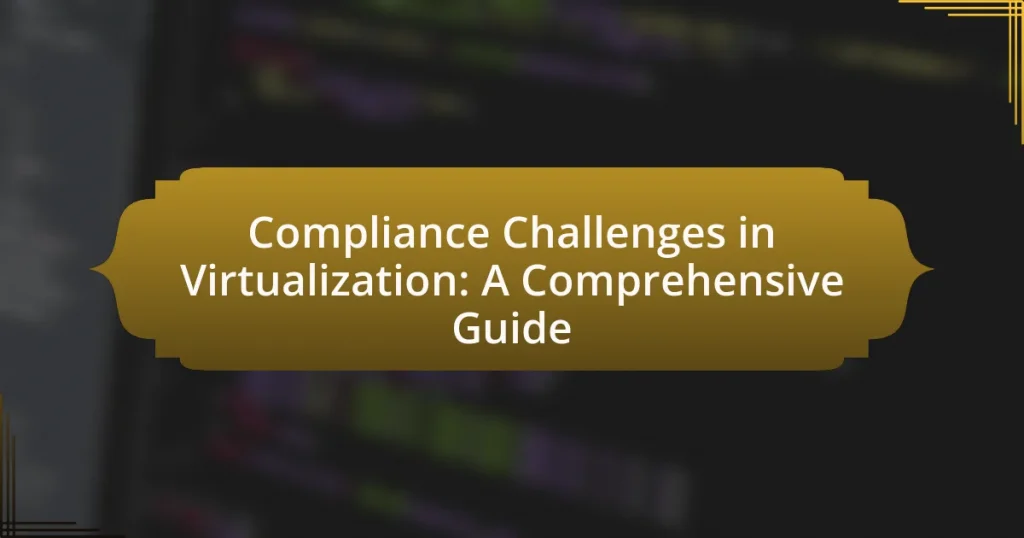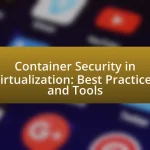The article “Compliance Challenges in Virtualization: A Comprehensive Guide” addresses the complexities organizations face in ensuring compliance within virtualized environments. It highlights key challenges such as data security, regulatory adherence, and resource allocation, emphasizing the importance of compliance with regulations like GDPR, HIPAA, and PCI DSS. The article further explores how compliance requirements vary across industries, the impact of non-compliance, and best practices for mitigating risks. Additionally, it discusses the role of technology and automation in enhancing compliance management, providing insights into future trends and effective methodologies for compliance assessment.
What are the Compliance Challenges in Virtualization?
Compliance challenges in virtualization include data security, regulatory adherence, and resource allocation. Virtual environments often complicate the enforcement of security policies due to the dynamic nature of virtual machines, which can lead to unauthorized access and data breaches. Additionally, organizations must navigate various regulations, such as GDPR and HIPAA, which impose strict requirements on data handling and storage. The complexity of managing virtualized resources can also hinder compliance efforts, as it becomes difficult to track and audit virtual assets effectively. These challenges necessitate robust governance frameworks and continuous monitoring to ensure compliance in virtualized environments.
Why is compliance important in virtualization environments?
Compliance is important in virtualization environments because it ensures that organizations adhere to legal, regulatory, and internal standards, thereby mitigating risks associated with data breaches and security vulnerabilities. In these environments, where multiple virtual machines share physical resources, maintaining compliance helps protect sensitive information and maintain the integrity of systems. For instance, regulations like GDPR and HIPAA impose strict requirements on data handling and privacy, making compliance essential for avoiding hefty fines and reputational damage. Furthermore, compliance frameworks often provide guidelines for security best practices, which are crucial in managing the complexities of virtualization and ensuring that all virtual assets are properly secured and monitored.
What regulations and standards must be considered in virtualization?
Regulations and standards that must be considered in virtualization include the General Data Protection Regulation (GDPR), Health Insurance Portability and Accountability Act (HIPAA), and Payment Card Industry Data Security Standard (PCI DSS). GDPR mandates strict data protection and privacy measures for organizations handling personal data of EU citizens, impacting how virtualized environments manage data. HIPAA sets standards for protecting sensitive patient information in healthcare, requiring secure virtualization practices to safeguard electronic health records. PCI DSS outlines security measures for organizations that handle credit card transactions, necessitating compliance in virtualized systems that process payment data. These regulations ensure that virtualization practices align with legal and security requirements across various industries.
How do compliance requirements differ across industries?
Compliance requirements differ significantly across industries due to varying regulatory frameworks, risk profiles, and operational practices. For instance, the healthcare industry must adhere to HIPAA regulations to protect patient data, while the financial sector is governed by regulations such as the Sarbanes-Oxley Act, which focuses on financial transparency and accountability. Additionally, industries like manufacturing may be subject to environmental regulations, such as the Clean Air Act, which mandates compliance with air quality standards. These differences arise from the unique nature of each industry’s operations, the types of data they handle, and the specific risks they face, necessitating tailored compliance strategies to meet legal and ethical obligations.
What are the common compliance challenges faced in virtualization?
Common compliance challenges faced in virtualization include data security, regulatory adherence, and resource allocation. Data security is critical as virtual environments can increase the risk of unauthorized access and data breaches due to shared resources. Regulatory adherence poses challenges because organizations must ensure that virtualized systems comply with various regulations, such as GDPR or HIPAA, which can be complex in a dynamic environment. Resource allocation issues arise when managing compliance across multiple virtual instances, making it difficult to maintain consistent security policies and audit trails. These challenges are compounded by the rapid pace of technological change and the need for continuous monitoring and updates to compliance strategies.
How does data security impact compliance in virtualized environments?
Data security significantly impacts compliance in virtualized environments by ensuring that sensitive information is protected according to regulatory standards. In these environments, where multiple virtual machines may share physical resources, the risk of data breaches increases, necessitating robust security measures to meet compliance requirements such as GDPR, HIPAA, or PCI-DSS. For instance, a study by the Ponemon Institute found that organizations with strong data security practices are 50% less likely to experience data breaches, which directly correlates with their ability to maintain compliance. Thus, effective data security not only safeguards data but also facilitates adherence to legal and regulatory frameworks, ultimately reducing the risk of penalties and enhancing organizational reputation.
What role does resource allocation play in compliance challenges?
Resource allocation is critical in addressing compliance challenges as it directly impacts the ability of organizations to meet regulatory requirements. Proper allocation of resources, including personnel, technology, and budget, ensures that compliance measures are effectively implemented and maintained. For instance, a study by the Ponemon Institute found that organizations with dedicated compliance teams and adequate funding are 50% more likely to meet regulatory standards compared to those without such resources. This highlights that insufficient resource allocation can lead to gaps in compliance, increasing the risk of penalties and legal issues.
How can organizations identify compliance gaps in virtualization?
Organizations can identify compliance gaps in virtualization by conducting regular audits and assessments of their virtual environments. These audits should include a review of security policies, access controls, and configuration settings to ensure they align with regulatory requirements and industry standards. For instance, organizations can utilize automated compliance monitoring tools that continuously evaluate virtual machines against predefined compliance benchmarks, such as those set by the National Institute of Standards and Technology (NIST) or the Health Insurance Portability and Accountability Act (HIPAA). This approach allows organizations to detect discrepancies in real-time, facilitating timely remediation of compliance issues.
What tools and methodologies are effective for compliance assessment?
Effective tools and methodologies for compliance assessment include automated compliance management software, risk assessment frameworks, and audit management tools. Automated compliance management software, such as RSA Archer or MetricStream, streamlines the process of tracking compliance requirements and managing documentation. Risk assessment frameworks like NIST SP 800-53 provide structured guidelines for identifying and mitigating risks associated with compliance. Additionally, audit management tools, such as AuditBoard or LogicManager, facilitate the planning, execution, and reporting of compliance audits, ensuring thorough evaluations of adherence to regulations. These tools and methodologies enhance the efficiency and accuracy of compliance assessments in various organizational contexts.
How can audits help in identifying compliance issues?
Audits help in identifying compliance issues by systematically evaluating an organization’s adherence to regulatory standards and internal policies. Through detailed examination of processes, documentation, and controls, audits reveal discrepancies and areas of non-compliance. For instance, a study by the Institute of Internal Auditors found that organizations with regular audits are 30% more likely to identify compliance gaps early, allowing for timely corrective actions. This proactive approach not only mitigates risks but also enhances overall compliance management.
How do Compliance Challenges Affect Virtualization Strategies?
Compliance challenges significantly impact virtualization strategies by necessitating stricter governance and control measures. Organizations must ensure that their virtual environments comply with regulations such as GDPR, HIPAA, and PCI-DSS, which often require specific data handling and security protocols. For instance, failure to comply with these regulations can result in substantial fines; GDPR violations can incur penalties of up to 4% of annual global turnover. Consequently, businesses may need to implement additional security layers, conduct regular audits, and maintain detailed documentation, which can complicate and slow down virtualization initiatives. This need for compliance can lead to increased costs and resource allocation, ultimately shaping the design and deployment of virtualization strategies.
What impact do compliance challenges have on virtualization adoption?
Compliance challenges significantly hinder virtualization adoption by creating barriers to implementation and increasing operational risks. Organizations often face stringent regulatory requirements that necessitate strict data governance and security protocols. For instance, industries such as finance and healthcare are subject to regulations like GDPR and HIPAA, which mandate specific controls over data access and storage. These compliance requirements can complicate the deployment of virtual environments, as organizations must ensure that their virtualization solutions meet these standards. Consequently, the fear of non-compliance can lead to delays in adopting virtualization technologies, as companies prioritize regulatory adherence over technological advancement.
How can compliance issues lead to increased costs?
Compliance issues can lead to increased costs primarily through penalties, fines, and the need for additional resources to address non-compliance. When organizations fail to adhere to regulatory requirements, they often face financial repercussions, which can include substantial fines imposed by regulatory bodies. For instance, the General Data Protection Regulation (GDPR) can impose fines up to 4% of annual global turnover for non-compliance. Additionally, organizations may incur costs related to legal fees, remediation efforts, and the implementation of compliance programs to prevent future violations. These expenses can significantly strain budgets and divert funds from other critical business operations.
What risks are associated with non-compliance in virtualization?
Non-compliance in virtualization poses significant risks, including data breaches, legal penalties, and operational disruptions. Data breaches can occur due to inadequate security measures, leading to unauthorized access to sensitive information. Legal penalties arise from failing to adhere to regulations such as GDPR or HIPAA, which can result in hefty fines and reputational damage. Operational disruptions may stem from non-compliance with licensing agreements, potentially causing service outages or loss of access to critical resources. These risks highlight the importance of maintaining compliance to safeguard data integrity and ensure business continuity.
How can organizations mitigate compliance risks in virtualization?
Organizations can mitigate compliance risks in virtualization by implementing robust governance frameworks and regular audits. Establishing clear policies that define roles, responsibilities, and compliance requirements ensures that all stakeholders understand their obligations. Regular audits help identify potential compliance gaps and assess adherence to regulations, such as GDPR or HIPAA, which are critical in virtualized environments. Additionally, utilizing automated compliance tools can streamline monitoring processes and provide real-time insights into compliance status, thereby reducing the risk of violations.
What best practices should be implemented for compliance management?
Best practices for compliance management include establishing a clear compliance framework, conducting regular risk assessments, implementing robust training programs, and maintaining thorough documentation. A clear compliance framework provides guidelines and standards that align with regulatory requirements, ensuring that all stakeholders understand their responsibilities. Regular risk assessments identify potential compliance gaps and allow organizations to proactively address them, reducing the likelihood of violations. Training programs ensure that employees are aware of compliance policies and procedures, fostering a culture of compliance within the organization. Thorough documentation serves as evidence of compliance efforts and can be critical during audits or investigations, demonstrating adherence to regulations. These practices collectively enhance an organization’s ability to manage compliance effectively and mitigate risks associated with non-compliance.
How can employee training enhance compliance in virtualization?
Employee training enhances compliance in virtualization by equipping staff with the necessary knowledge and skills to adhere to regulatory standards and best practices. Training programs focused on virtualization can cover critical areas such as data security, access controls, and incident response, ensuring that employees understand their roles in maintaining compliance. For instance, organizations that implement regular training sessions report a 30% reduction in compliance violations, as employees become more aware of the risks and responsibilities associated with virtualization environments. This proactive approach not only fosters a culture of compliance but also minimizes the likelihood of costly breaches and penalties.
What are the Future Trends in Compliance and Virtualization?
Future trends in compliance and virtualization include increased automation, enhanced data privacy regulations, and the adoption of multi-cloud environments. Automation in compliance processes will streamline monitoring and reporting, reducing human error and improving efficiency. Enhanced data privacy regulations, such as the General Data Protection Regulation (GDPR) and the California Consumer Privacy Act (CCPA), will necessitate stricter compliance measures in virtualized environments to protect sensitive information. Additionally, the shift towards multi-cloud strategies will require organizations to navigate complex compliance landscapes across different platforms, emphasizing the need for robust governance frameworks. These trends reflect the evolving landscape of technology and regulatory requirements, driving organizations to adapt their compliance strategies accordingly.
How is technology evolving to address compliance challenges in virtualization?
Technology is evolving to address compliance challenges in virtualization through the development of advanced monitoring tools, automated compliance frameworks, and enhanced security protocols. These innovations enable organizations to maintain regulatory standards by providing real-time visibility into virtual environments, automating compliance checks, and ensuring data protection. For instance, tools like VMware vRealize Operations and Microsoft Azure Security Center offer integrated compliance management features that help organizations adhere to regulations such as GDPR and HIPAA by continuously assessing configurations and identifying vulnerabilities. This evolution is crucial as it allows businesses to efficiently manage compliance in increasingly complex virtual infrastructures.
What role does automation play in compliance management?
Automation plays a crucial role in compliance management by streamlining processes, reducing human error, and ensuring adherence to regulatory requirements. By automating tasks such as data collection, reporting, and monitoring, organizations can maintain accurate records and respond swiftly to compliance changes. For instance, a study by the International Compliance Association found that companies utilizing automation in compliance processes experienced a 30% reduction in compliance-related errors, demonstrating the effectiveness of automation in enhancing compliance accuracy and efficiency.
How are emerging regulations shaping virtualization strategies?
Emerging regulations are significantly influencing virtualization strategies by necessitating enhanced compliance measures and data protection protocols. Organizations are increasingly adopting virtualization solutions that align with regulatory requirements, such as GDPR and HIPAA, which mandate strict data handling and privacy standards. For instance, companies are implementing virtualized environments that facilitate better data segregation and access controls to meet these legal obligations. This shift not only ensures compliance but also mitigates risks associated with data breaches, as evidenced by the fact that organizations face substantial fines for non-compliance, with GDPR fines reaching up to 4% of annual global turnover. Thus, the interplay between emerging regulations and virtualization strategies is driving a more secure and compliant IT infrastructure.
What are the key takeaways for ensuring compliance in virtualization?
Key takeaways for ensuring compliance in virtualization include implementing robust security measures, maintaining accurate documentation, and conducting regular audits. Security measures such as encryption and access controls protect sensitive data within virtual environments. Accurate documentation of configurations and policies ensures that compliance requirements are met and can be demonstrated during audits. Regular audits help identify vulnerabilities and ensure adherence to regulatory standards, thereby reinforcing compliance efforts.
What steps can organizations take to stay compliant in a virtualized environment?
Organizations can stay compliant in a virtualized environment by implementing robust security protocols, conducting regular audits, and ensuring proper data management practices. Establishing security measures such as firewalls, intrusion detection systems, and encryption helps protect sensitive information. Regular audits, including vulnerability assessments and compliance checks, ensure adherence to regulations like GDPR or HIPAA. Additionally, organizations should maintain clear documentation of their virtualized infrastructure and data handling processes to demonstrate compliance during inspections or audits. These steps are essential for mitigating risks associated with virtualization and maintaining regulatory compliance.
How can continuous monitoring improve compliance outcomes?
Continuous monitoring enhances compliance outcomes by providing real-time insights into regulatory adherence and operational practices. This proactive approach allows organizations to identify and address compliance issues as they arise, rather than relying on periodic audits that may overlook critical violations. For instance, a study by the Institute of Internal Auditors found that organizations employing continuous monitoring reported a 30% reduction in compliance breaches compared to those using traditional methods. This demonstrates that continuous monitoring not only improves the detection of non-compliance but also fosters a culture of accountability and transparency within organizations.




